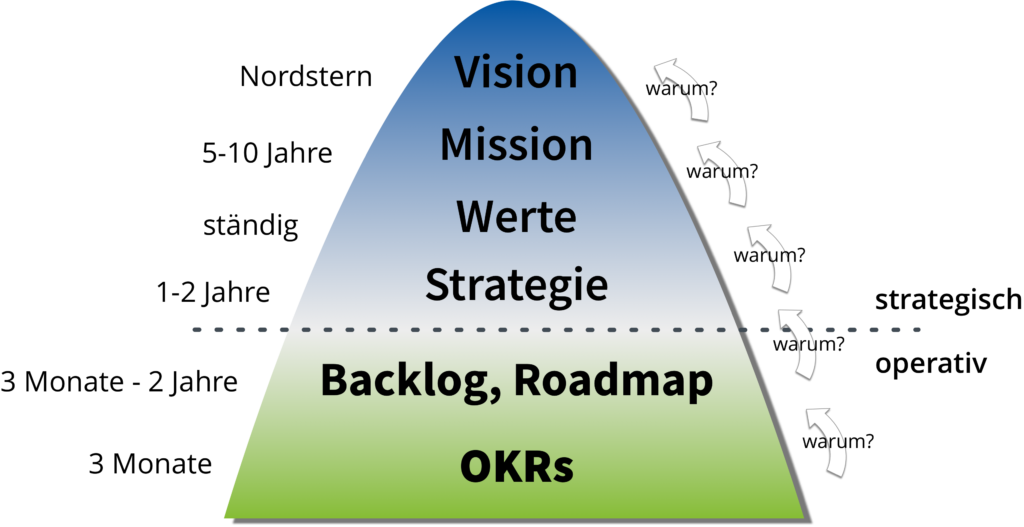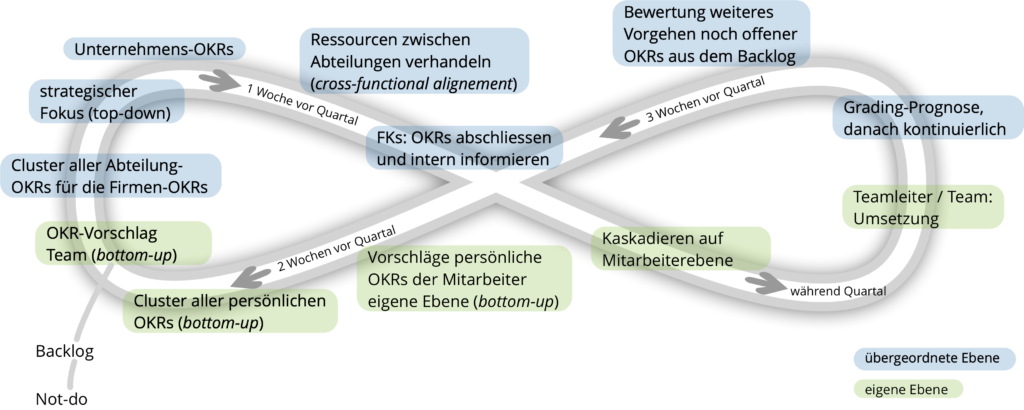OKRs(objectives and key results) are a leadership model to focus attention on the right issues, leverage effort and drive a shift from tasks to objectives.
What’s new about OKRs
OKRs have similarities to KPIs, but also significant differences. They also don’t yet have the bad reputation that KPIs have received due to their unfortunate linkage to reward systems.
Like KPIs, they are an implementation of “management by objectives”: an employee is given tasks and the implementation of the tasks is evaluated. Tasks are created by each supervisor distributing or cascading their tasks to their employees. KPIs are therefore a strictly hierarchical system.
In OKRs, on the other hand, the supervisor and the employees (or teams) each develop their own ideas and these are then compared. It’s kind of a negotiated settlement. There are various solutions to the question of how decisions are made in the event of a conflict: in the “intel” variant, the superior decides in case of doubt. In the “Google” variant, the question remains open and one trusts that peer pressure will lead to an amicable solution.
Another essential element of OKRs is complete transparency about goals – across hierarchical levels and horizontally between teams and departments.
History: Where do OKRs come from?

OKR as a method
OKRs(objectives and key results) are a leadership model to focus attention on the right issues, leverage effort and drive a shift from tasks to objectives.
- create alignment, and catalyze decisions on the way to achieving a goal
- do not anticipate decisions on how to achieve the goal
Success is not checking a box. Success is having an impact.
Christina Wodtke Tweet

| objectives | key results |
| ambitiously formulate a state or benefit in the future | are the measurable way to achieve the goal |
top-down + bottom-up: full transparency, OKRs in all departments |
|
A key result of the upper level ideally becomes the objective of the level below. Projects should be broken down into milestones. Stretch goals are OK.
Benefits: Alignment and focus
Vision, mission and strategy are translated into a focus for the next 3 months.
- transparent, communicated priorities help to work in a concentrated manner
- alignment: all employees gain an understanding of the big picture
- opportunities disappear: it is clear what is done and not done and why
- clear decisions with scarce resources
OKR process
The process proceeds in a cadence, in month/s or quarters, and has recurring times when something happens:

|
Objectives
|
Key Results
|
|---|---|
|
WHAT we want to achieve: Contribution to what strategic goals? |
HOW can we observe that the objective has been achieved? |
|
qualitatively formulated, inspiring and easy to remember
Clear ownership, no dependencies, measurable result
|
quantitatively measurable, value-creating key results
|
| ‘How do we enable more people to become more mobile without a car in the Ruhr?’ |
‘Our integrated mobility offer was used 1000 times in one month’ |
|
Customer satisfaction, financial success (revenue, savings) Employee development (skills, lateral cooperation) Contribution to the common good (social acceptance). |
Distinguish tasks from key results
Initiatives, Tasks, Projects, Activities are, what we think we need to do to achieve our objective.
Distinguish a Key Result from a Task
Does my KR measure an effort or a value-added outcome?
‘We wrote 5 technical papers on Y’ < > ‘We have 100 new subscribers to our Z newsletter.’
Tasks instead of KRs were defined when …
- there is the impression of having done something for the company goal, but this action is not reflected in the KRs (‘customer event held’).
- tasks to be completed are formulated, to-do lists are drawn up
|
activity based KR |
value based KR |
|
Launch new training |
Achieve NPS of y% Generate 100 leads Give 5 trainings |
|
Introduce OKR in the company |
80% of all MA use OKR as a new framework 100 MA have done training on OKR 5 OKR coaches trained |
Turn Task into Key Result
What value have I generated for my customers, my team? How can I tell?
If we are successful with ______ we will have more/less of ________ .
‘If we know which jobs to focus on, then we have more time (x hours) for active selling.’
Fictitious example for an organic grocer
key result: In the metropolitan areas, organic vegetables come to the customer when the customer does not come to the organic food store.
- Same Day Delivery logistics implemented in three major German cities
- Launch One Click Ordering App
- Win 100 private customers in city districts that match the socio-demographics of the target group for organic vegetable subscriptions
- Perform promotion with at least 10 sales per hour on average
objective technology
- Connecting the logistics of Same Day Delivery partners
- Enable customers to place mobile orders with one click
- Launch app for iOS and Android
- Implement customer accounts in web and app
- Implement secure data storage for payment data with external partner
- Responsive fall back for website implementation
objective marketing
- Conduct market test to validate organic vegetable subscription
- 10000 private customers informed via flyer, social media campaign
- Conduct profitable SEM campaign to acquire 50 family customers
- 5% of landing page users convert to customers with retargeting
Evaluation, Grading
An evaluation of the results(grading) is only necessary from the last 3 weeks weekly and draws concentration on topics which could still be completed.
If 70% of the target is reached, the target is considered to have been reached.
| 70-100% | Courage to set ambitious stretch goals. |
| 50-69% | Not ideal. Topic should be reviewed for the next quarter. |
| 0 – 49% | No or little progress. Why? Still relevant? Topic goes in the backlog, move or delete? |
OKRs vs. bonus systems
OKRs should be decoupled from bonuses or variable pay programs:
- OKRs promote intrinsic motivation
- Sales revenue targets can appear in OKR sets and can also be cascaded
- social loafing becomes visible or is revealed through group dynamics
Ambitious OKR target formulations are only possible without a bonus system. Thus, 75% target achievement cannot be evaluated as good in the OKR system and have a negative impact on the remuneration. Linking with team bonuses or incentives is possible (on the contribution margin of the department).